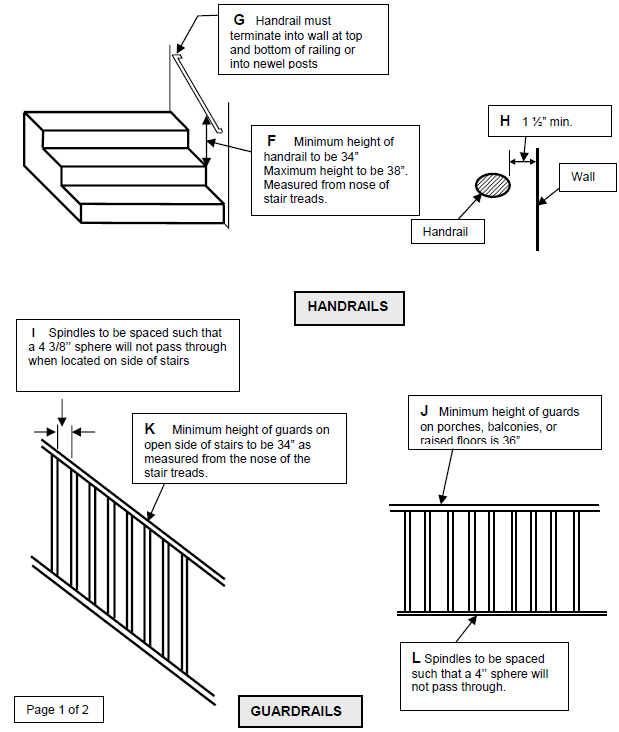The 2015/2018 International Residential Code (IRC)…
contains railing guidelines similar to those found in the Florida Building Code 6th & 7th Edition (2017, 2020). Below are selected regulations from the 2018 IRC for reference as they are typically used on our safeguard projects.
Helpful 2018 IRC PDF also appears by clicking here (courtesy Safebuilt Colorado)
R311.7 Stairways
R311.7.1 Width
Stairways shall be not less than 36 inches (914 mm) in clear width at all points above the permitted handrail height and below the required headroom height. The clear width of stairways at and below the handrail height, including treads and landings, shall be not less than 311/2 inches (787 mm) where a handrail is installed on one side and 27 inches (698 mm) where handrails are installed on both sides.
Exception: The width of spiral stairways shall be in accordance with Section R311.7.10.1.
R311.7.8 Handrails
Handrails shall be provided on not less than one side of each flight of stairs with four or more risers.
R311.7.8.1 Height
Handrail height, measured vertically from the sloped plane adjoining the tread nosing, or finish surface of ramp slope, shall be not less than 34 inches (864 mm) and not more than 38 inches (965 mm).
Exceptions:
The use of a volute, turnout or starting easing shall be allowed over the lowest tread.
- Where handrail fittings or bendings are used to provide continuous transition between flights, transitions at winder treads, the transition from handrail to guard, or used at the start of a flight, the handrail height at the fittings or bendings shall be permitted to exceed 38 inches (965 mm).
R311.7.8.2 Handrail Projection
Handrails shall not project more than 41/2 inches (114 mm) on either side of the stairway.
Exception: Where nosings of landings, floors or passing flights project into the stairway reducing the clearance at passing handrails, handrails shall project not more than 61/2 inches (165 mm) into the stairway, provided that the stair width and handrail clearance are not reduced to less than that required.
R311.7.8.3 Handrail Clearance
Handrails adjacent to a wall shall have a space of not less than 11/2 inches (38 mm) between the wall and the handrails.
R311.7.8.4 Continuity
Handrails shall be continuous for the full length of the flight, from a point directly above the top riser of the flight to a point directly above the lowest riser of the flight. Handrail ends shall be returned or shall terminate in newel posts or safety terminals.
Exceptions:
- Handrail continuity shall be permitted to be interrupted by a newel post at a turn in a flight with winders, at a landing, or over the lowest tread.
- A volute, turnout or starting easing shall be allowed to terminate over the lowest tread.
R311.7.8.5 Grip Size
Required handrails shall be of one of the following types or provide equivalent graspability.
- Type I. Handrailswith a circular cross section shall have an outside diameter of not less than 11/4 inches (32 mm) and not greater than 2 inches (51 mm). If the handrail is not circular, it shall have a perimeter of not less than 4 inches (102 mm) and not greater than 61/4 inches (160 mm) and a cross section of not more than 21/4 inches (57 mm). Edges shall have a radius of not less than 0.01 inch (0.25 mm).
- Type II. Handrailswith a perimeter greater than 61/4 inches (160 mm) shall have a graspable finger recess area on both sides of the profile. The finger recess shall begin within 3/4 inch (19 mm) measured vertically from the tallest portion of the profile and have a depth of not less than 5/16 inch (8 mm) within 7/8 inch (22 mm) below the widest portion of the profile. This required depth shall continue for not less than 3/8 inch (10 mm) to a level that is not less than 13/4 inches (45 mm) below the tallest portion of the profile. The width of the handrail above the recess shall be not less than 11/4 inches (32 mm) and not more than 23/4 inches (70 mm). Edges shall have a radius of not less than 0.01 inch (0.25 mm).
R311.8 Ramps
R311.8.1 Maximum Slope
Ramps serving the egress door required by Section R311.2 shall have a slope of not more than 1 unit vertical in 12 units horizontal (8.3-percent slope). Other ramps shall have a maximum slope of 1 unit vertical in 8 units horizontal (12.5 percent).
Exception: Where it is technically infeasible to comply because of site constraints, ramps shall have a slope of not more than 1 unit vertical in 8 units horizontal (12.5 percent).
R311.8.2 Landings Required
There shall be a floor or landing at the top and bottom of each ramp, where doors open onto ramps, and where ramps change directions. The width of the landing perpendicular to the ramp slope shall be not less than 36 inches (914 mm).
R311.8.3 Handrails Required
Handrails shall be provided on not less than one side of ramps exceeding a slope of one unit vertical in 12 units horizontal (8.33-percent slope).
R311.8.3.1 Height
Handrail height, measured above the finished surface of the ramp slope, shall be not less than 34 inches (864 mm) and not more than 38 inches (965 mm).
R311.8.3.2 Grip Size
Handrails on ramps shall comply with Section R311.7.8.5.
R311.8.3.3 Continuity
Handrails where required on ramps shall be continuous for the full length of the ramp. Handrail ends shall be returned or shall terminate in newel posts or safety terminals. Handrails adjacent to a wall shall have a space of not less than 11/2 inches (38 mm) between the wall and the handrails.
Section R312 Guards
R312.1.1 Where Required
Guards shall be provided for those portions of open-sided walking surfaces, including stairs, ramps and landings, that are located more than 30 inches (762 mm) measured vertically to the floor or grade below at any point within 36 inches (914 mm) horizontally to the edge of the open side. Insect screening shall not be considered as a guard.
R312.1.2 Height
Required guards at open-sided walking surfaces, including stairs, porches, balconies or landings, shall be not less than 36 inches (914 mm) in height as measured vertically above the adjacent walking surface or the line connecting the nosings.
Exceptions:
- Guards on the open sides of stairs shall have a height of not less than 34 inches (864 mm) measured vertically from a line connecting the nosings.
- Where the top of the guard serves as a handrail on the open sides of stairs, the top of the guard shall be not less than 34 inches (864 mm) and not more than 38 inches (965 mm) as measured vertically from a line connecting the nosings.
R312.1.3 Opening Limitations
Required guards shall not have openings from the walking surface to the required guard height that allow passage of a sphere 4 inches (102 mm) in diameter.
Exceptions:
- The triangular openings at the open side of stair, formed by the riser, tread and bottom rail of a guard, shall not allow passage of a sphere 6 inches (153 mm) in diameter.
- Guards on the open side of stairs shall not have openings that allow passage of a sphere 43/8 inches (111 mm) in diameter.

Last Update: March 31, 2022
